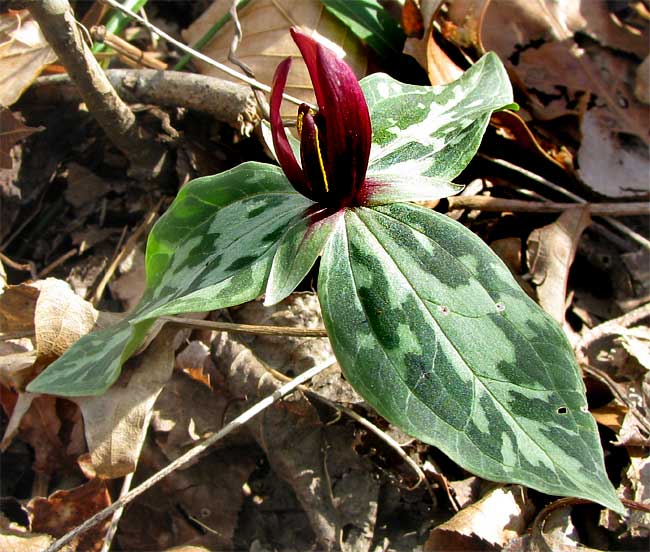Excerpts from Jim Conrad's
Naturalist Newsletter

from the the March 9, 2009 Newsletter, issued from the forest near Natchez, Mississippi; elevation ~400ft (120m), ~N31.47°, ~W91.29°:
OUR ABUNDANT, ENDEMIC TRILLUM
Wildflower lovers in North America know trilliums as quintessential "spring wildflowers" -- early blooming, colorful, perfect size for admiring, woods-loving species. Forty to fifty species are recognized so they also can tease our brains when we want to know which species we have.
Currently in our upland pine/oak woods there's a trillium species so common and so conspicuous that after a while the eye stops noticing them. The thing is, in the whole world this species is found only in a small section of Louisiana and here in southwestern Mississippi. It's a true endemic, a species that wildflower fanciers in other parts of the world would feel honored to meet. You can see one next to my door showing the trilliums' distinctive three-petaled, three-sepaled flower atop a stem bearing three leaves above.
This trillium species wasn't recognized as a distinct species until 1975 so it has no commonly accepted English name. Technically it's TRILLIUM FOETIDISSIMUM. Since foetidissimum means "very stinky," some book writers have called it the Fetid Trillium. Since it occurs only in our tiny area of the lower Mississippi Valley, others call it the Mississippi River Wakerobin, Wakerobin being a name sometimes applied to trilliums. A map showing its limited distribution at http://www.efloras.org/object_page.aspx?object_id=8107&flora_id=1.
Why does such a narrowly endemic wildflower species live in our area? Here's my guess:
The most closely related species to our Trillium foetidissimum is Trillium sessile, a common species in much of eastern North America, often called Toadshade or Sessile-flowered Wakerobin. Now look at Toadshade's distribution map at http://www.efloras.org/object_page.aspx?object_id=8117&flora_id=1.
That map shows that Toadshade's center of distribution is in the Indiana, Ohio, West Virginia area, but interesting unconnected or disjunct populations occur in places like northeastern Arkansas and southeastern Tennessee. When I see such disjunct populations for a species I assume that at an earlier time the species enjoyed a more extensive distribution, but now something has happened, possibly a change in climate, causing the population to withdraw from part of its distribution, leaving "islands" of plants behind. We've seen this a lot in the mountains of southern Mexico where plant communities were pushed south during the last Ice Age, then when the glaciers withdrew "sky islands" of very disjunct populations of eastern North American plants were left atop mountains down there.
So, I'm betting that long, long ago our area lay well within Toadshade's distribution area, but then that species began withdrawing northward, probably because of long-term warming after the last ice age. At first our disjunct "relict" trillium populations remained genetically the same as Toadshades, but as millennia passed and our population's gene pool acquired its own peculiarities not shared with the northern Toadshades, gradually our distinct species arose.
I'm just guessing on this story, but it's a story that's been confirmed for many species.